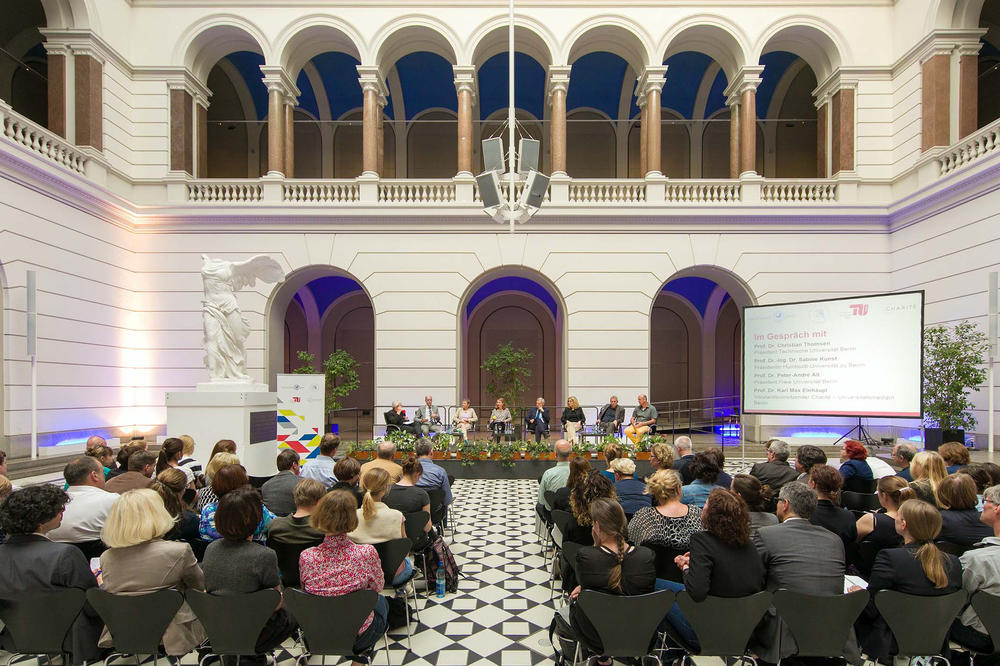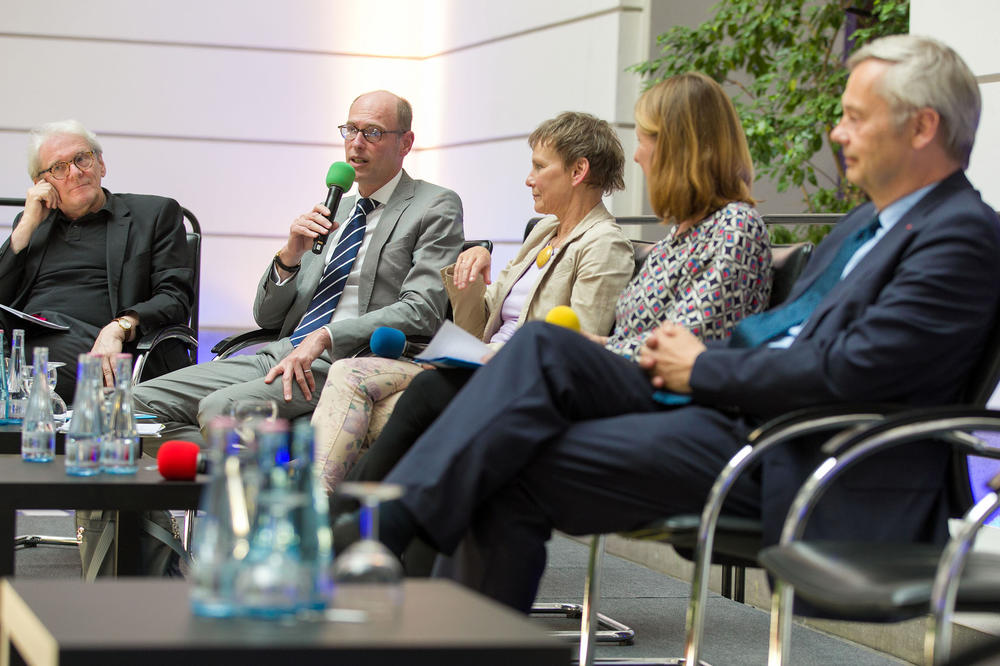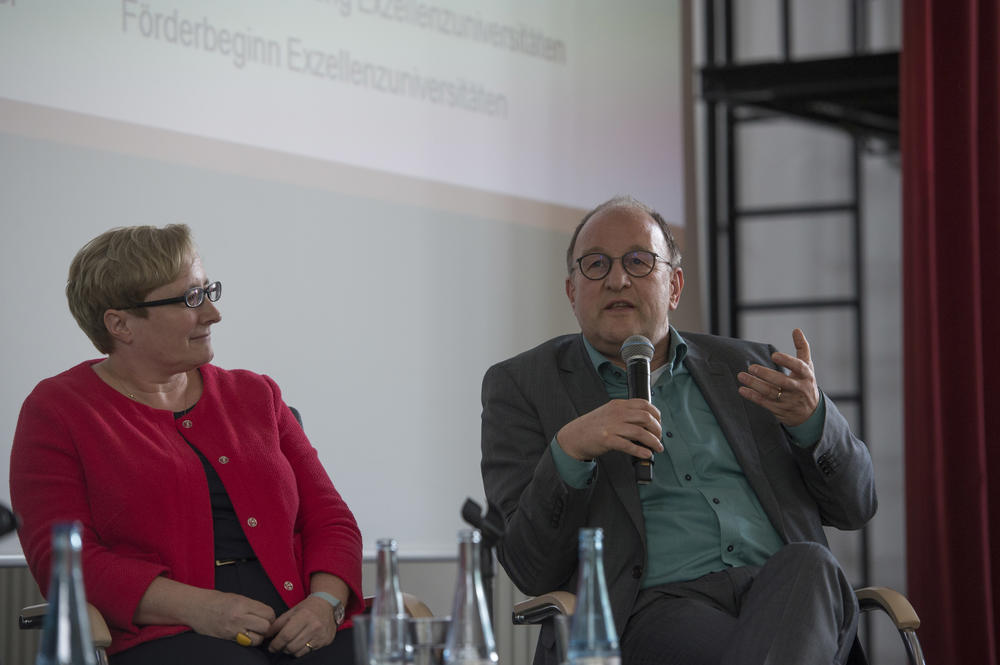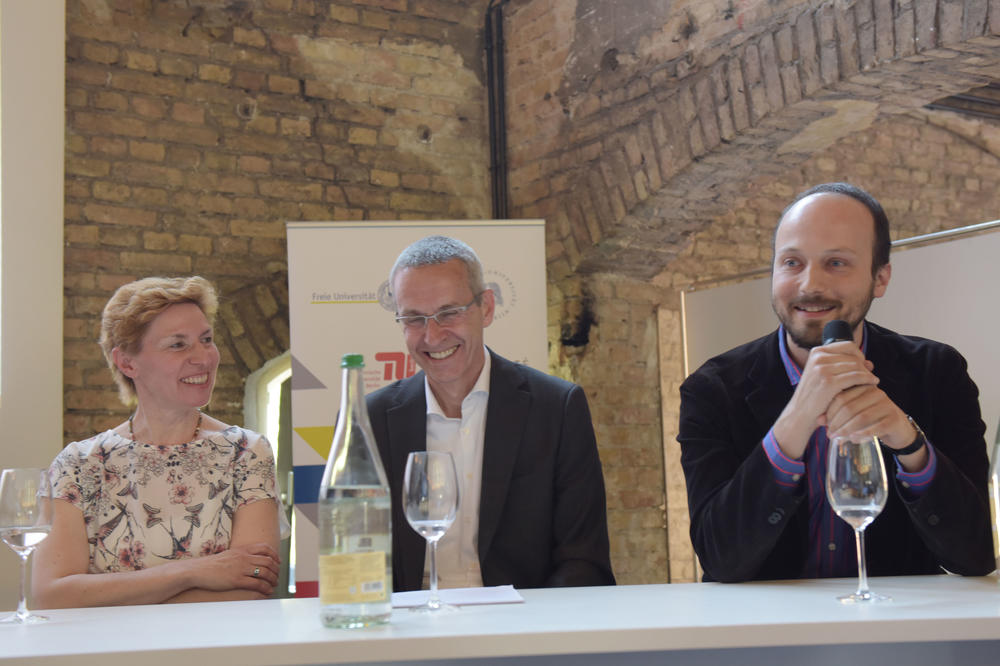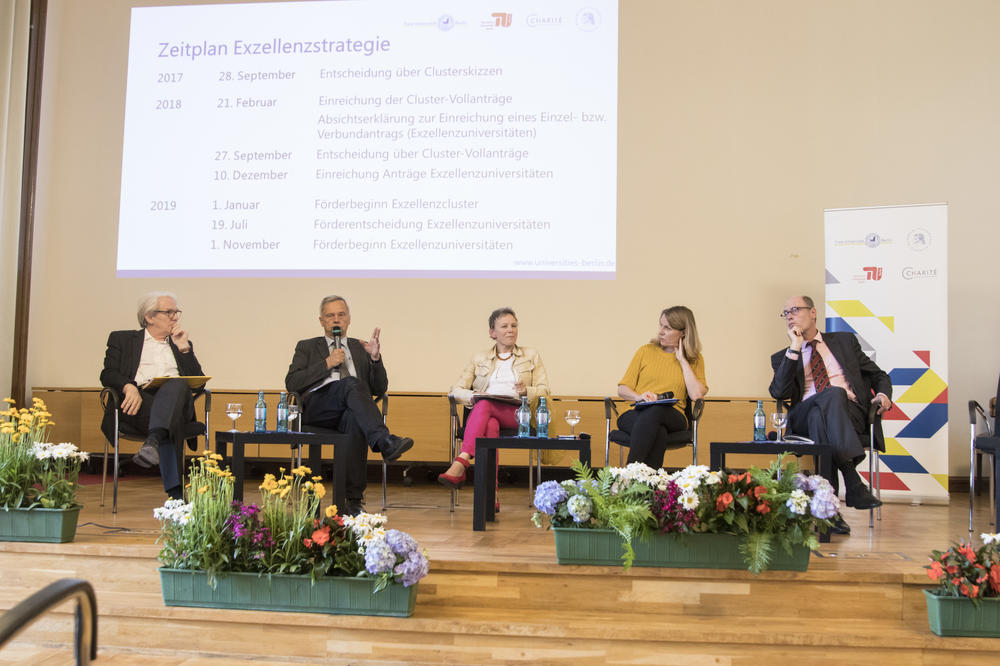Concerted Efforts
A series of panel discussions at the participating institutions provided opportunities for the three major Berlin universities and Charité to present their joint initiative for the Excellence Strategy.
Sep 21, 2017
The “Campus dialogue” series kicked off in the atrium of Technische Universität Berlin…
Image Credit: TU Berlin/PR/Michael Setzpfandt
“The more we cooperate, the more I ask myself why we didn’t think of doing this before.” Professor Karl Max Einhäupl, chairman of the board of Charité-Universitätsmedizin Berlin, is not alone in thinking that more can be achieved through concerted efforts. In agreement with him are Professor Sabine Kunst, the president of Humboldt-Universität zu Berlin, and the presidents of Freie Universität Berlin and Technische Universität Berlin, Professor Peter-André Alt and Professor Christian Thomsen. The decision by the four institutions to cooperate in the Excellence Strategy – the successor program to the Excellence Initiative – is the right one. The 2017 summer semester Campus Dialogue offered opportunities for discussion as to why the four institutions are convinced that research across departmental and institutional demarcations will go on to achieve more positive outcomes, and what the Excellence Strategy will bring to the universities. At all four institutions, the presidents of Freie Universität, Humboldt Universität zu Berlin, Technische Universität, and the Chief Executive Officer of Charité, together with involved professors, informed their audiences of the planned application as an alliance. Susanne Führer of Deutschlandfunk Kultur radio program moderated the discussions and at the end of each one, the audience – including employees, academics, and students – were allowed to ask questions and contribute constructive criticism.
Auf bestehende Strukturen bauen
…where universities’ presidents and the Chief Executive Officer of Charité were on the panel, with Susanne Führer of Deutschlandfunk Kultur taking on the role of moderator.
Image Credit: TU Berlin/PR/Michael Setzpfandt
First off the mark for the Campus Dialogue was Technische Universität Berlin. Sabine Kunst said that the proposed Excellence alliance would be able to build on existing structures. “A shared infrastructure means that conditions for researchers can improve.” Christian Thomsen summarized it like this: “We have taken up the challenge of forming a world-class location.” Yet the alliance was “not meant as an umbrella over other umbrellas,” added Peter-André Alt. In fact, it was the opposite: “The idea is to reduce the complexity of structures.” Referring to a view that crops up with a certain frequency, the moderator asked, “Why not simply found a Berlin “super-university”?” “Because diversity and a profile that has been developed over time are important to us,” replied Alt. “We want to preserve our asymmetries and differences – these are what give us our strength.” In other words, cooperating with each other: yes. Merging, no.
The president of Freie Universität added that an alliance would not have any effect on the organization of the individual institutions. Each university would continue to pursue its institutional goal of maintaining a particularly high profile, both nationally and internationally. Indeed, this would be entirely conducive to working in collaboration. The significant fields of action in which an allliance of institutions could be active, are the appointments strategy, support for junior researchers, research initiatives, use of resources and infrastructure, transfer of knowledge, and digitalization. In response to a question from the audience, Alt confirmed that students too would stand to benefit from the subsidies that would result from a successful joint application. “Excellence means more funds for everyone.”
Verena Blechinger-Talcott, professor of Japanese studies, and Michael Meyer, professor of prehistoric archaeology, both of Freie Universität, were also on the panel.
Image Credit: Bernd Wannenmacher
What applies to Europe is also true for research, was Einhäupl’s response to the moderator’s question on the advantages of a joint application. Together, universities are stronger. “Research is now a matter of regions rather than institutions.” Thomsen added that Berlin is a research center of enormous diversity. and that such diversity is best reflected in a joint application. “It would in fact be harder to defend a decision not to cooperate more closely,” he said.
The scholars on the panels also gave the concentration of expertise in the universities as the reason for putting together cross-institutional applications, as has been the practice for some considerable time. At the Campus Dialogue in the atrium of Technische Universität Berlin, TU scientist Volker Mehrmann, math professor and head of Matheon research center, Matthias Driess, chemistry professor and spokesperson for the UniCat Cluster of Excellence, and Martina Löw, professor of architecture and planning sociology, spoke about their experience of leading large research alliances and consortia. “It is at the borders between disciplines that progress and innovation occurs. As a scientist, one has to go beyond the horizon, beyond the lines demarcating departments and institutions,” said Mehrmann.
Professors Christine Sers of Charité, Ulrich Dirnagl, and Benjamin Judkewitz talked about their experiences with the Excellence Initiative.
Image Credit: Wiebke Peitz
Another person whose experience tells him that cooperation across universities bears results for research is Michael Meyer, who joined the panel for the Campus Dialogue at Freie Universität. He is a professor of prehistoric archaeology at Freie Universität and one of two spokespersons at the Topoi Cluster of Excellence, a research association on antiquity which was set up in 2007 by Freie Universität and Humboldt Universität with the additional participation of nonuniversity institutions. “Topoi has now gained universal recognition,” says Meyer, “and this comes from our working across disciplines and institutions on all things relevant to the topic of antiquity.” Verena Blechinger-Talcott, professor of Japanese Studies and Günter Ziegler, math professor at Freie Universität and spokesperson for the graduate Berlin Mathematical School (BMS), cited further examples of the advantages of cooperation.
Stronger together: Prof. Karl Max Einhäupl (Charité), Prof. Christian Thomsen (Technische Universität), Prof. Sabine Kunst (Humboldt-Universität), and Prof. Peter-André Alt (Freie Universität) (from left to right) with moderator Susanne Führer (2nd f
Image Credit: Ralph Bergel
Enabling Research Opportunities
At the event in the Henry Ford building at Freie Universität, Alt said that the current parlance was more about “enabling research structures and less about research topics.” Chief Executive Officer of Charité Karl Max Einhäupl emphasized, “We want to create the best possible conditions for top-class research in Berlin.”
Talking at the main building of Humboldt-Universität on Unter den Linden were Caren Tischendorf, professor of applied mathematics at Matheon, and Jörg Niewöhner, professor of urban anthropology and human-environment relations at the Department of European Ethnology and a member of IRI THESys – Transformation of Human-Environment Systems. “Research as an association is not about being better or faster than your peers. The aim is to solve problems,” says Tischendorf. According to the mathematician, concerted efforts achieve more where investments are concerned, too. One example is the acquisition of a mainframe computer which can be used by all institutions. Further representatives of scientific endeavor were present at the Campus Dialogue that took place in the Museum of Medical History at Charité, in the so-called Lecture Hall Ruin. Molecular biologist Christine Sers, Ulrich Dirnagl, Director Experimental Neurology at the Clinic of Neurology and assistant spokesperson of the NeuroCure Cluster of Excellence, and Benjamin Judkewitz, a fundamental researcher in bioimaging and neurophotonics at the NeuroCure Excellence Cluster, reported on their cross-institutional experience of research. “We scientists must work together so that we can think beyond the confines of what we are accustomed to. This involves talking to various other disciplines, exchanging information and learning from other scientists – and hence developing our own ideas further,” said Sers.
But what happens if the institutions do not make it through the application procedure? “We are confident,” Ziegler replied to moderator Führer’s question. “If we are not successful, we would still do the work,” she added, “only in a smaller format.” There would still be a need to band together in the interests of science. Finally, Führer asked what might be the picture with regard to academia in Berlin in the year 2025. “Berlin will be a city of science and humanities knowledge, attracting academics from Germany and the entire world,” said Thomsen.
Further Information
The German Government’s Excellence Strategy
The Excellence Strategy of the German government is the successor program to the Excellence Initiative, from which the Berlin institutions have already benefited to a considerable extent. The new competition has two lines of support: the “Clusters of Excellence,” which are large research networks, and the “Universities of Excellence,” or, as a new concept, “University Excellence Consortia,” which must possess convincing strategic concepts for the sustainable development of research institutions.
The state of Berlin is supporting the local alliance initiative under the German government’s Excellence Strategy. The universities stand to receive 3.5 million euros in the next two years for the preparation of proposals.

